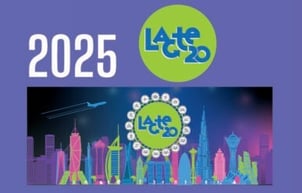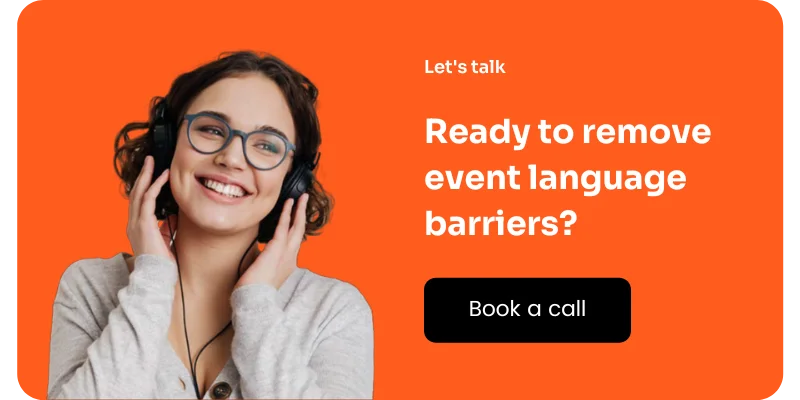Adding language interpretation to on-site events has traditionally been a logistical challenge. It often involved finding interpreters and then organizing their travel, food, and accommodation — to say nothing of sourcing and setting up interpretation equipment.
Fortunately, since 2014, Remote Simultaneous Interpretation (RSI) technology has made interpretation faster, easier, and more cost-effective to organize than ever before. In this article, we’ll explore how RSI works for on-site events, the benefits of RSI, and what event planners should look for in an ideal RSI solution.
Contents
1. How simultaneous interpretation works for in-person events
2. Comparing traditional on-site interpreting with RSI
3. How RSI makes it easier to organize language access at your in-person event
4. Examples of RSI set-ups for on-site events
5. What do you need to add RSI to your on-site event
1. How simultaneous interpretation works for in-person events
Simultaneous interpretation is the act of interpreting speech from one language to another, while that speech is still being spoken. Under traditional set-ups, this requires interpreters to sit in soundproof booths at the venue, while the audience listens to their interpretation using headsets.
With RSI, this task is performed without interpreters needing to be physically present at events. Instead, interpreters use a cloud-based RSI platform to provide their services in real time from anywhere in the world.
All interpreters need to provide their service is a laptop, access to your chosen RSI platform, a strong internet connection, a microphone, and a high-quality stream of the event. Unlike traditional on-site interpretation, where you are restricted by space and the cost of setting up multiple interpreter booths, RSI has no space limitations on the number of languages you can offer.
This seems simple enough. But how do audiences access language interpretation? Event planners have two options. They could provide the audience with wireless headsets that broadcast a live feed from the RSI platform. Or attendees can download your RSI partner’s app onto their device, enabling them to listen to interpretation in the language of their choice. Many RSI platforms can be accessed via an app or web browser.
Another option, you can always use RSI alongside traditional in-person interpretation. One benefit of this approach is that it takes the same interpretation that those in the event space are listening to and shares it with anyone that requires it, regardless of where they are — such as a journalist sitting in a press tent or a remote speaker.
2. Comparing traditional on-site interpreting with remote interpreting
When organizing on-site interpretation, event planners are responsible for renting and setting up interpretation equipment and finding, briefing, and managing interpreters. With the traditional on-site route, you also need to consider how interpreters will travel to the venue, whether they can be there on time, if they need accommodation, and what provisions they need when they are there. That’s a lot of work on top of everything else that goes into planning and running an event.
As RSI enables remote language interpretation for on-site events, it can significantly reduce the logistical burden and costs of hiring interpreters. Moreover, RSI platforms, like Interprefy, will take over the key responsibilities of organizing interpretation, including sourcing, briefing, and the day-to-day management of talent. Event planners need to identify which languages they want to cater for, and their RSI partner will handle the rest.
Other benefits of using RSI include:
- Greater choice of venue — without the need to set up large interpretation booths, you have more choice between venues.
- It’s more environmentally friendly — with fewer people travelling to the event, RSI helps reduce the environmental impact of events.
- Access to a wider pool of talent — instead of relying on locally available interpreters, RSI enables access to a large and global pool of talent, making it easier to find best-fit interpreters.
- RSI is more reliable — from last-minute changes to cancellations, and delayed flights, fewer variables can go wrong when interpreters work remotely. And, if an interpreter becomes unavailable, RSI platforms leverage their network of talent to quickly find a replacement.
- Language interpretation can be scaled — if you add an online element to your on-site event, language interpretation can be included, often at no additional cost. Multiple languages can also easily be added to your event without additional effort on your part.
- More efficient configuration — sending and receiving interpretation is significantly more efficient, as your RSI partner does all of the logistical heavy lifting. This is more efficient than organizing equipment, interpreters, and setting up equipment and booths at the venue.
- Access to user statistics — with RSI, you’ll know what languages your audience has listened to, as opposed to only knowing how many receivers were distributed. This way, you’ll be able to assess how well your budget is spent regarding language provision.
- Improved user experience — with multilingual meeting technology providers like Interprefy, you can offer your audience a wider range of language accessibility options, including live captioning and sign language. But with traditional on-site interpreting, you’re restricted to audio-based language interpretation.
Significantly, these benefits are enjoyed without compromising on the quality or reliability of service.
3. How RSI makes it easier to organise language access at in-person events

4. Examples of RSI set-ups for on-site
As we’ve seen, RSI is not always a replacement for on-site interpretation. In fact, it can be used as a means to increase reach, scalability, and versatility. Here’s how RSI can be applied to three different types of on-site events.
Scenario 1: All interpreters are on-site but RSI is used to stream language interpretation.
Imagine you’re organizing a large multilingual conference and your client wants on-site interpretation facilitated by traditional booths and IR receivers. Complicating matters, the main stage is to be broadcast to seven rooms. At the same time, you need to enable simultaneous interpretation for up to 10 languages. The traditional solution would involve running kilometres of cables over a massive area. These cables would connect to dozens of laptops while crisscrossing between each room, the main stage, and interpreter booths.
RSI solves these challenges by providing a cloud-based solution that streams uninterrupted language interpretation to the local audio network of each area in the event. Audiences then could listen to the event over headsets and in the language of their choosing.
Interprefy provided RSI for this exact scenario — helping simplify the logistics for the World Government Summit.
Scenario 2: All interpreters work remotely
You need to provide language interpretation to over 18,000 in-person guests. This requires sourcing over 50 interpreters, who you need to organize transport and accommodation for. Securing so many interpreters is challenging, as you can only choose between talent that is able to travel to the venue. where more qualified candidates are unavailable.
Herbalife was in a similar situation when they opted for remote interpretation. Our technology enabled real-time professional interpretation in 27 languages while our AV partners monitor the event to ensure a smooth experience for organizers, attendees, and technicians.
With our RSI solution, Herbalife had access to a wider range of talent and AV technicians had easy and professional language relays management.
Scenario 3: A mix of remote and on-site interpretation
You need on-site interpreters but transporting your interpreters is a challenge. Some may fall sick, for instance, or the destination may make travel too large of a logistical challenge.
The Inter-Parliamentary Union (IPU) adopted a mix of remote and on-site interpretation to solve two of their interpretation issues. The first is that transporting interpreters increases the carbon footprint of events. The second is that IPU events happen in different locations every year. This increases logistical complexity — especially as different audio-visual providers are required for each event.
Embracing a mix of interpretation methods lessened the logistical burden as fewer booths and equipment were required. As their RSI provider, we also provided project management support. At the same time, their carbon emissions were reduced as fewer interpreters and hardware required transportation to and from the event.
5. What do you need to add RSI to your on-site event?
To start enjoying the benefits of remote interpretation technology in your next in-person event, get in touch with our team. We’ll discuss how our solution can meet the live translation needs of your events.
On the day of the event, all your AV team will need is a computer that can stream the live audio and video feeds of your on-site event to Interprefy via a simple browser page.
Our solution has empowered many multilingual hybrid events — and our customers include the likes of Google, UEFA, and J.P Morgan.
With a long history of providing interpretation for on-site events, our service includes extensive technical and project support. We believe that you should get exactly what you pay for, so we tailor our quotes to match the exact requirements and circumstances of each event.





 More download links
More download links



